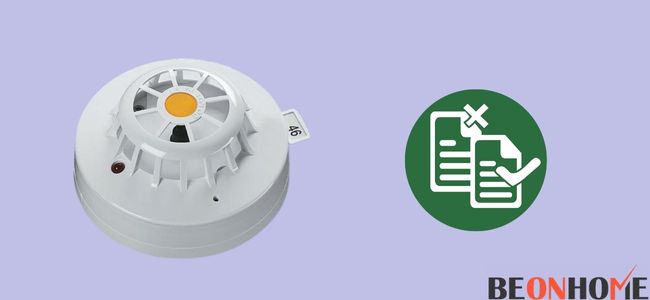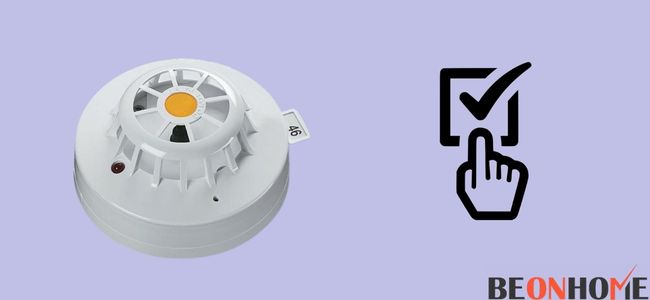The U.S Fire Administration (USFA) reports claims that there are approximately 7000 garage fires yearly. Fires in the garage may not be that obvious, and smoke detectors could delay the process of detecting and putting out fires.
Unlike smoke detectors, heat detectors sense a temperature rise and aim to save property from fire damage, especially in garages.
Keep reading to learn the different types of heat detectors for garages and safety tips for installation and maintenance.
Heat Detector For Garage And Safety Tips
Heat detectors sense a rapid change in temperature in the environment and set the alarms off. They are mainly installed to protect against damage to property in case of fire or possible fires.
The heat detectors are set to tolerate a specific temperature threshold, and once that is crossed, the alarms go off and act as a warning to transfer property.
Heat detector alarms can be mechanical or electronic. The mechanic alarms works based on the principle of hot air expanding and triggering the alarm.
Electronic heat detectors use a thermistor, which changes its resistance with a temperature change and triggers the alarm.
Here are few things to remember while setting up heat detectors:
1. Select A Heat Detector

Use heat detectors in an interconnected system. An interconnected system ensures more safety by ensuring people in any part of the house can be alerted.
2. Buy Alarms With 175-250 °F Temperature Ratings
Buy alarms with 175-250° F temperature ratings. The general heat level in a garage is above 100° F. Alarms with lower heat resistance are more prone to give false warnings. The higher temperature ratings will also balance the heat when garages get hot during summer.
3. Choose A Hard-Wired Heat Alarm

Hard-wired heat detectors are more reliable than battery-run ones. The hard-wired and interconnected system is connected to the main power supply and comes with a battery backup which has lesser chance of failing.
4. Mechanical Sound And Sparkling
Do not set up heat detectors close to fluorescent lights, as they can trigger fall alarms. Also, leave a considerable distance from other electrical equipment.
5. Try To Follow The User Manual Properly

Seek professional assistance to install and set up the heat detectors and follow the instructions on the user manual properly.
6. Take Expert Assistance To Install The Heat Detector
- Ensure the heat detectors are well maintained. Regularly check the wire connections and replace batteries when needed.
- Organize your garage and limit potential obstacles in events of emergency. Make sure to organize and contain flammable materials, like oil, chemicals, etc., properly. Clean up the garage of liquid spills like oil, chemicals, or water.
- Avoid running the vehicle engine frequently inside the garage. This can raise the temperature, lead to potential fires, and build up carbon monoxide ( a flammable gas) inside the garage.
- Do not use extension cables for connecting electrical appliances in the garage.
- Use heat detectors that can be monitored remotely. Smart devices can be accessed from anywhere using smartphones and alert you even if you aren’t in the house.
FAQ
1. Are Heat Detectors Safe?
Heat detectors cannot be the sole safety equipment. Heat detectors are primarily for environments like auditoriums, garages, and kitchens where many contaminants in the air, like smoke, fumes, and dust particles, could falsely trigger smoke alarms. It cannot be used as a replacement for smoke detectors.
Heat detectors can sense a rapid rise in temperature and help take actions to evacuate people and property; however, a change in temperature is still relatively a delayed phenomenon, especially in case of active fires.
It doesn’t detect if smoke fills up the room and therefore is not recommended for bedrooms, hallways, and other places inside the home.
2. Why Do I Need CO Detectors?
Carbon monoxide detectors are recommended addition to ensure safety in the garage. CO detectors sense the level of CO in the air and alert you when it exceeds the threshold.
There’s always a minimum level of CO present in the air around us; however, when it gets accumulated in a contained room like a garage, it can make the whole area inflammable.
It can also leak into the entire house, and it can cause suffocation to the residents of the house. Since the gas is poisonous and explosive, it is necessary to monitor the level of CO in closed rooms and inside homes.
Final Talk
Heat detectors are least likely to give false alarms in garages, but they cannot be used in isolation. They must be built into garages, carbon monoxide detectors, and smoke detectors in nearby hallways. Ensuring safety in garages also includes organizing and cleaning the garage regularly. Situations and objects that can cause or escalate fires must be removed. Equipping yourself with smart technology can help monitor garages even when you aren’t physically present at home.

Leave a Reply